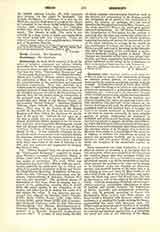

Ceremonial, the book which contains in detail the order of religious ceremony and solemn worship prescribed to be observed in ecclesiastical functions. At present there are only two official liturgical books that bear the titles, “Caeremoniale Romanum” and “Caeremoniale Episcoporum“. The Missal, Breviary, Ritual, and Pontifical likewise contain directions for the celebration of Mass, the recitation of the Office, the administration of the sacraments, and episcopal functions respectively. They may, therefore, in a certain sense be considered ceremonials; but since the primary purpose of these books is to serve as texts of the liturgical prayers, the added directions being only general, they are not looked upon as ceremonials in the accepted sense of the term. The most ancient ceremonials and rituals of the Roman Church are the so-called “Ordines Romani“. Mabillon (Mii um Italicum, Paris, 1687-89, II) enumerates fifteen of them. They treat of the election of the Roman pontiff, the Sacrifice of the Mass, the Sacraments of Baptism and Holy Orders, the functions for special days of the year, etc. Authors do not agree as to the date at which they were composed. Abbot Hilduinus, Walafridus Strabo, Sigebertus (in his chronicle), and after them Leopoldus Bambergensis, record that the Roman pontiff sent a copy of one of these “Ordines” to Pepin of Heristal (d. 714) or to Charles Martel (d. 741). It was probably composed by the pontifical master of ceremonies and contained, besides the functions observed in the various churches at that time, many rites and customs taken from a similar book which dates back to the time of Gelasius I (d. 496), and was corrected and augmented by Gregory the Great (d. 604).
The “Ordines Romani” were the ground-work of the “Caeremoniale Romanum”, compiled by Angustinus Patricius, surnamed Piccolomineus, Bishop of Pienza (1483-1496), who had been formerly pontifical master of ceremonies. The work, which was dedicated to Innocent VIII, March 1, 1488, was not intended originally for publication, but in 1516 it was printed by pontifical permission at Rome and Venice by Christophorus Marcellus, Archbishop of Corcyra, under the title “Rituum Ecclesiasticorum, sive Sacrarum Caeremoniarum S. Romance Ecclesiae libri tres non ante impressi”. The pontifical master of ceremonies at that time, Paris de Grassis, was incensed at its publication, averring that it would lower the papal dignity in the estimation of the masses, and asked Leo X to destroy the copies of it and censure the editor. It was, however, not suppressed, but reissued at Florence (1521); Cologne (1557); Rome (1560); Venice (1573, 1582, 1616); Leipzig (1733), and at Rome (1750), with a commentary by Joseph Catalanus under the title “Sacrarum Caeremoniarum, sive Rituum Ecclesiasticorum S. Romance Ecclesiae libri tres, ab Augustin Patricio ordinati et a Marcello Corcyrensi Archiepiscopo primum editi”. It consists of three books, the first of which contains extra-liturgical functions, such as the election and consecration of the Roman pontiff, the coronation of an emperor, the canonization of saints, the creation of cardinals, etc.; the second describes the liturgical functions at Mass, Vespers, and the other canonical Hours; the third gives general rules and instructions. In 1587 Sixtus V established the Congregation of Ceremonies for the purpose of watching over the rites and ceremonies which are to be observed in the Papal Court, to decide questions regarding preeminence among the persons who assist at the papal functions, to arrange all the details for the presentation of princes and their envoys to the Roman pontiff, and to give directions to the ablegates who carry the insignia of the cardinalate to newly-created cardinals residing outside of Rome. Many dioceses and monastic orders have their proper ceremonials, and those compiled by individual authors for giving assistance to the clergy in the performance of their ecclesiastical functions are very numerous.
A. J. SCHULTE

